Pathfinders
Dr. Hulda Clark’s View on Cancer Research
Based on conversations with her in 2008 and research she recommended
“Great spirits have always found violent opposition from mediocrities.” -Albert Einstein
In every field, new pathways are typically forged by those who dare to think outside the box. The medical field is no exception. In medicine, practically every new idea, every new theory, every new method of healing has come not from mainstream medicine, but rather from outside the stifling confines of the monolithic medical establishment.
Pasteur’s idea, for example, that germs caused disease, met with serious opposition. In 1875 the body of medical opinion was entirely unwilling to concede that devastating diseases such as cholera, diphtheria, scarlet fever, syphilis and smallpox could possibly be caused by microorganisms.
Penicillin was first discovered in 1896 by a 21 year-old French medical student named Ernest Duchesne. But because Duchesne was young and a student, his work was largely ignored and his landmark discovery was written off as a curiosity. It was not until 1928 that Penicillin was “rediscovered” by Scottish physician Alexander Fleming.
In 1847, while working in the maternity department of a Vienna hospital, Dr. IgnazSemmelweis proposed that physicians wash their hands after performing autopsies and before attending to pregnant women. His suggestion was rejected and ridiculed by the medical community. After 14 years of trying to gain acceptance of his ideas Dr. Semmelweis died insane in a mental institution.
Scores of other medical visionaries also went through hell for simply challenging the prevailing medical opinion of their day. These include William Harvey in the 17th Century for his theory of the circulation of blood, and in more recent years, Stanislaw Burzynski, Virginia Livingston-Wheeler and Harry Hoxsey, for their revolutionary approaches to cancer treatment.
Back in the 1930s, biologist John Bittner was studying a strain of mice in which breast cancer ran in the family. This suggested the cause was genetic – and yet if the pups were taken away from their mothers at birth and fostered by other females, they did not develop the disease. The answer, Bittner soon realized, was that something in the milk of the cancer-prone mice must be causing the tumors. Over the following years it was shown to be a virus, called the mouse mammary tumor virus or MMTV. Its discovery raised an obvious question: might a similar virus cause breast cancer in people, too?
Bittner’s theory was considered implausible, and was largely ignored. Yet today, after a 70-year lapse, evidence is rapidly mounting that the so-called human mammary tumor virus (HMTV, closely related to MMTV) actually causes breast cancer.
Particularly poignant and tragic, as well as especially pertinent to our discussion, is the story of Royal Raymond Rife. Royal Raymond Rife was a brilliant American interdisciplinary scientist born in 1888. He worked in the fields of optics, electronics, radiochemistry, biochemistry and aviation. Royal Raymond Rife received 14 major awards and honors and was given an honorary Doctorate by the University of Heidelberg for his work.
If a required technology didn’t exist, Rife invented it. In 1920, financed by millionaire Henry Timken, Rife built the ingenious and incredibly complex Universal Microscope, which consisted of 5,682 parts. The Universal Microscope was capable of magnifying objects 60,000 times their normal size. With this extraordinary microscope, Rife became the first human being to actually see a living virus.
In the same year, 1920, Royal Raymond Rife identified what he suspected to be the human cancer virus. To prove his theory, he injected the newly discovered virus into lab animals, creating 400 tumors in succession from the same culture. He documented everything with film, photographs, and meticulous records. Rife named the cancer virus Cryptocidesprimordiales.
In his laboratory in San Diego, California, Rife evolved the revolutionary technique of using sound waves to destroy killer viruses. By increasing the intensity of a frequency that resonated naturally with that of the microbes, Rife increased their natural oscillations until they distorted and disintegrated from structural stresses. Rife called this frequency the mortal oscillatory rate. The mortal oscillatory rate, he discovered, effectively destroyed the virus and did no harm whatever to the surrounding tissues.
By experimenting with many different resonant frequencies, Rife discovered, over a period of time, frequencies that specifically destroyed herpes, polio, spinal meningitis, tetanus, influenza, and a number of other deadly organisms. A seeming success story of the greatest magnitude, the story of a priceless discovery of enormous benefit to humanity. And yet, by 1939, nearly everyone in the medical profession had turned against Royal Raymond Rife, including most of the medical authorities who, in 1931, had attended a fête in Rife’s honor called “The End To All Diseases.” Rife was savagely attacked by the AMA and governmental agencies. His revolutionary cure for cancer was shut down before it became widely available. Rife’s laboratory was vandalized, his records stolen, his microscope damaged. Ultimately his research was ignored, discredited and suppressed.
The reason? Both pharmaceutical corporations and doctors stood to lose both their honor and millions if Rife’s method would prevail. The corporations would lose income from patented drugs and doctors would have to “begin anew their period of infancy and education or yield their patients and their livelihood to those better informed.” As quoted from Morris Fishbein, AMA’s “pro big pharma” corrupt editor of JAMA.14
- Cancer: Public Enemy No. 1
Despite intensive and expensive research, there has been no significant reduction in cancer deaths over the past 50 years. Cancer is as lethal as ever and may soon overtake heart disease as the biggest killer of Americans. 2 - Metastasis is the Problem
It is not localized tumors that kill people with cancer, but rather it is the process of metastasis—an incredible 90% of the time. Aggressive cells spread to the bones, liver, lungs, brain, or other vital areas, doing irreparable damage. Yet the tragic fact is that of nearly 8,900 NCI grant proposals awarded last year, 92% didn’t even mention the word metastasis. 3 - Honest Researchers Toiling in a Skewed System
The majority of researchers and people working in the pharmaceutical corporations honestly believe that they are doing the right thing. Unfortunately, they are working within the confines of a skewed and unresponsive system that they have unwittingly become accustomed to over the years. - A Dysfunctional Cancer Culture
The so-called War on Cancer is being conducted by a dysfunctional cancer culture that pushes tens of thousands of physicians and scientists toward the goal of finding minuscule improvements in treatment rather than genuine breakthroughs. 4 - No Shortage of Cash
The National Cancer Institute’s budget for the year 2004 was a whopping $4.7 billion. Other agencies chipped in another $9.7 billion. The lion’s share ($6.0 billion) came, significantly, from the big drug companies. 5 - The Pursuit of Knowledge
In today’s world of cancer research, the quest for knowledge has become an end unto itself rather than the means to an end. Research has become increasingly narrow, so much so that physician-scientists who want to think systemically about cancer or the organism as a whole very often can’t get funding. 6 - Narrow Focus, Fat Funding
Grant money goes almost entirely to researchers who focus on very specific genetic or molecular mechanisms within the cancer cell or other tissue. The narrower the research niche the greater the rewards the researcher is likely to attain. 7 - Mouse Models are Inadequate
Homer Pearce, former head of cancer research and clinical investigation at Eli Lilly, allows that mouse models are “woefully inadequate” for determining whether a drug will work in humans. “If you look at the millions and millions and millions of mice that have been cured, and you compare that to the relative success, or lack thereof, that we’ve achieved in the treatment of metastatic disease clinically,” he says, “you realize that there just has to be something wrong with those models.” 8
This is not to say the scientists and researchers involved in cancer research are cynical opportunists. That would be far from the truth. The great majority of researchers are unquestionably sincere in their desire to help humanity. They are dedicated individuals who perceive themselves as being engaged in work that will be of benefit to their fellow man. But like most of us, these researchers and scientists have house payments and car payments, and children to put through college. And unfortunately, if they want to keep their jobs, they have to swim with the current. They are pawns in an ill-conceived system of useless treadmills, worn-out paths and bureaucratic wickets, a machine that funnels them, like rats in a maze, into sterile cubbyholes.
A perfect example is the case of a small molecule known as DCA that may offer hope of a cancer cure by repairing the damage that cancer cells cause to mitochondria, the components of cells that convert food into energy.
“DCA attacks a fundamental and unique property of cancer. It puts the mitochondria back in the normal condition, and because the mitochondria can control cell death, that also comes back into the picture,” says Dr. EvangelosMichelakis, a professor at the University of Alberta department of medicine.8
No less exciting than the fact that DCA seems so promising in fighting cancer is that the compound is incredibly cheap to produce. DCA is widely available at chemistry stores, in both liquid and powder form. It’s not patented, not owned by any drug company, and not likely to generate a huge profit. While this ultimately is a good thing, it’s also the reason why pharmaceutical companies have very little interest in funding further DCA research. Since DCA cannot be patented and drug companies don’t make money on non-patented treatments, Michelakis says, “industry is not particularly interested.”9
Under the present system funding for research on DCA and any nutrients (herbs, vitamins, amino acids, digestive enzymes and chemicals) that are not patentable is meager and must come from charities, universities and governments.
“We hope we can attract the interest of universities here in Canada and in the United States,” Dr. Michelakis says.
Here and there, other scientists and researchers are standing up and speaking their piece. Jean-Pierre Issa, who studies leukemia, is frustrated by the cancer community’s mindset. Still, he admits, the system’s lure is powerful. “You get a paper where you change one gene ever so slightly and you have a drastic effect of cancer in the mouse, and that paper gets published in Science or Nature, and in your best journals. That makes your reputation. Then you start getting grants based on that,” he says.11
“The incentives are not aligned with the goals,” says Leonard Zwelling, Issa’s colleague and vice president for research administration at M.D. Anderson. “If the goal is to cure cancer, you don’t incentivize people to have little publications.” 12
“It’s like a Greek tragedy,” observes Andy Grove, the chairman of Intel
and a prostate-cancer survivor, who for years has tried to shake this cultural mindset as a member of several cancer advisory groups. “Everybody plays his individual part to perfection, everybody does what’s right by his own life, and the total just doesn’t work.” 13
Within the next decade, cancer is likely to replace heart disease as the leading cause of U.S. deaths, according to forecasts by the NCI and the Centers for Disease Control and Prevention. Cancer is responsible for more deaths than the next three causes (heart disease, accidents, and stroke) put together. It is also the leading disease killer of children.
Why aren’t we winning the war on cancer? It is because the cancer culture subscribes to a mentality that pushes physicians and scientists toward the goal of finding minuscule improvements in treatment rather than genuine breakthroughs, and rewards academic achievement and publication over all else. Generous grants, averaging $338,000 apiece in 2003, are awarded to researchers who focus on very specific genetic or molecular mechanisms within the cancer cell. The narrower the research niche, the greater the rewards for the researcher. The original goal, primary goal of all the research, that of curing cancer, is being overlooked.
Moreover, the mouse models used in research are unsuited for the task at hand. A mouse gene may be very similar to a human gene, but the rest of the mouse is very different. Because mice are expendable, they are treated with high doses of chemicals that would be toxic to a human. The findings, therefore, are largely irrelevant with regard to curing cancer in the human being.
The present system that will never deliver cancer cures no matter how hard well-meaning researchers try, and no matter how much money is spent. No one can ever find a cure for cancer by relying on the system we now use for cancer research. Here is why:
The system calls for the use of patented drugs only
It costs $800 millions in research to bring a cancer drug to market. The required level of research for cancer drugs is impossible to finance unless you have a patent on the drug. Consequently, even the most amazing herbal research does not stand a chance.
The system calls for a “magic bullet”
Since cancer is caused by many factors and each type of cancer is believed to have many variations (mutations) the cure may not be found in “one pill” but rather in a combination of several.
The system does not allow for research on humans
In their pursuit of developing a single “magic bullet” for cancer, pharmaceutical companies have to develop an extremely toxic chemical capable of killing the cancer. Unfortunately, they risk killing the patient also. For this reason, no research can be performed on humans.
The system calls for minimizing risk in research
Spending $800 million on research is risky business. Funding goes to projects that have a high probability of success, such as drugs that reduce tumor size. The companies therefore focus on reducing the tumor size (kills 10% of cancer victims), rather than stopping metastasis (kills 90% of cancer victims) because it is easier to show efficacy in shrinking tumors
The solution for cancer is to spend majority of all research grants on finding nutraceutical (foods having a medicinal effect on human health) cures for cancer. This research should be funded by NCI and the leading NGOs and made freely available to all.
Dr. Clark wanted the system changed in the following way:
- Cancer research and treatment has to involve Health Researchers, such as Biologists, Physicists, Naturopathic Physicians, Herbalists, MDs and others.
- Research has to involve a regimen of non-toxic nutraceuticals, diet and lifestyle changes. Not one “magic pill.”
- Research has to be done directly on humans, not lab rats.
- This research needs to be well financed with National Cancer Institute’s and other agencies’ money.
- All relevant discoveries made on NCI’s money have to be patented by NCI and made freely available for use by any company and the public. Discoveries have to be made into Guidelines for Healthcare Professions
- FDA has to mandate all Healthcare Professionalsand Healthcare Researchers to use nutraceuticals to treat and research cancer, using NIC Guidelines for Healthcare Professionals
Unfortunately the system will never change if there is no financial gain for the stakeholders in the existing system. Since change from within the system is extremely unlikely, other avenues must be pursued if change is to be effected. For example, If professionals across the spectrum (biologists, chemists, herbalists, doctors and others), in USA and in nations that support alternative cancer researchers (not penalize it), would take the lead and prove to the world the effectiveness of alternative medicine, the balance of power over cancer research would quite possibly change. It is imperative therefore that other nations take a leading role in cancer research since the US has neglected and corrupted the system to a degree that has resulted in unnecessary death and suffering for Americans and for people worldwide.
The US government has officially reported that cancer is decreasingly a problem in America. But California officials have revealed that the US Veterans Administration (VA) stopped reporting cancer cases to state registries in late 2004. These omissions significantly skew cancer statistics and allow unscrupulous politicians to report a “decline” in cancer rates.
Now we come to the case of Dr. HuldaRegehr Clark.
As we have seen, new frontiers are most often forged by researchers working outside the established order. HuldaRegehr Clark is just such a researcher. Throughout her career, Dr. Clark has displayed a dedication and steadfastness of purpose that resonates with the dedication of Royal Raymond Rife and the other great researchers who preceded her.
Early on, Dr. Clark began to question the prevailing medical model as a way to regain health. In 1979, she left government funded research to begin her own consulting practice. By 1981, she felt she had discovered the cause of disease. In 1993, after conducting exhaustive tests based on her findings she took an unprecedented step. She boldly challenged the authorities by publishing abook titled The Cure For All Cancers. Why bold? Because the word “cure” is reserved by law for the exclusive use of the medical community. Dr. Clark’s next book was bolder still. It was entitled: The Cure For All Diseases. Two succeeding books unabashedly featured the word “cure” in the title: The Cure For HIV and AIDS, and The Cure For All Advanced Cancers.
What had Dr. Hulda Clark discovered? She found that where there was cancer or any other diseases, there were also parasites present. Our bodies have been subjected to environmental pollutants and processed foods on a massive scale in recent decades. Dr. Clark’s books outline a comprehensive program for regaining health. She identifies common household products, vitamin supplements and mercury-based dental filling, as well as processed foods, that weaken the body and thereby contribute to disease. She details comprehensive herbal programs that will help the body rid itself of parasites.
Like her courageous predecessors, Dr. Clark has had to endure repeated attacks by the US government and the medical establishment. Dr. Clark has been called, not without good reason, “the most persecuted doctor on the planet.” She has been hounded, arrested and maligned. Why? Because she is unabashedly concerned with cures, as her books, The Cure for All Cancers and The Cure for All Diseasesunequivocally indicate.
Dr. Clark favors a nutraceutical approach. Her “subjects” are human beings, not mice. They are patients who have benefited from her protocols. Instead of toxic chemicals Dr. Clark uses natural herbs. Her approach addresses the cause of cancer, rather than treating symptoms. Nevertheless, her books are not intended as a critique of current classical management of cancer. She is fully aware that licensed oncologists must practice within the boundaries of conventional treatments. Her protocols do not exclude conventional treatments, but rather, Dr. Clark asserts, the two can work hand in hand.
Dr. Clark’s protocol consists of a combination of methods, applied in an interrelated manner. The idea is to fully detoxify the body, so that the immune system can take over with full control.
Dr. Clark’s work is based in part on an audio oscillator circuit called the Syncrometer, with which she determines the actual causes of cancer and other health conditions. Knowing the cause opens the door to prevention and treatment. Dr. Hulda Clark has treated over 2,000 cancer patients in the last 15 years. Her audio oscillator circuit techniques are unfortunately not easily learned, and funding is needed for perfecting this highly sophisticated skill. Those not familiar with the audio oscillator may dismiss it at face value, without getting proper training. As a point of interest, a similar type of oscillator is now being used in medical research by many naturopathic physicians and oncologists, notably Dr. John Holt.
Dr. Clark finds that cancer is–not surprisingly–a complex mechanism, involving factors from environmental toxins to toxins produced in the human body by certain pathogens to parasites, fungi and bacteria.
Patients with a beginning cancer, with just a small tumor, less than the size of a marble, may be able to clear it up with the simple program given in Dr. Clark’s first book, The Cure for all Cancers. A major cleanup program follows: teeth, diet, home and body products are all thoroughly screened for substances that burden the immune system. After this cleansing program, the revitalized immune system is free to work its healing magic.
Dr. Hulda Clark is unique among authors with respect to the copyright notice that appears in her books. Dr. Clark states unequivocally that anyone is free to copy the text of her books for any non-commercial purpose, including posting passages from the books on the Internet. The Internet, Dr. Clark believes, is a democratic vehicle for the broad dissemination of ideas, especially new or controversial ideas of any kind.
It was in this context that Dr. Hulda Clark coined the phrase “self-health,” by which she meant that the public, through education, can ultimately take care of its own health.
Dr. Clark has consistently encouraged people to take ownership of their health care, rather than relying exclusively on their doctors. As the saying goes, if you want something done right, do it yourself. How? Do your research, then find a qualified herbalist or natural practitioner with experience in your particular condition. If you are on medications, look them up in the PDR (Physician’s Desk Reference, available online) and check for interactions (possible reactions with other drugs, food or herbs).
The high incidence of cancer in recent years is due to avoidable exposures to a multiplicity of environmental carcinogens. Meanwhile, the National Cancer Institute is engaged in largely irrelevant research, research that has little to do with the real-life problems faced by cancer patients. A rule of thumb is: the narrower the research niche, the greater the rewards. What this means at the end of the day is that cancer research is fundamentally flawed in its orientation.
A far better and more useful direction would be the stopping of metastases, which kill the great majority of cancer patients. Aggressive cells spread to the bones, liver, lungs, brain, or other vital areas, devouring and destroying. And yet Fortune magazine reports that, going back to 1972, less than 0.5 percent of study proposals focused primarily on metastases. Of nearly 8,900 grant proposals awarded in 2003, 92 percent didn’t even mention the word “metastasis.” The basic fact is that economics rules cancer therapy. What this dynamic precludes is any serious investigation of non-toxic, less toxic, natural, nutritional, or immunological approaches to cancer. These highly desirable protocols are square pegs trying to fit into round holes.
Orthodox doctors, however well meaning and highly educated, have received little training in herbal medicine. For them, prescribing herbs is risky business because they would be ultimately obliged to refer the patient to an herbalist. When was the last time you heard of a doctor doing that? Doctors that have
learned nutritional therapies risk losing their medical license if they prescribe Nutraceuticals.
As Dr. Clark herself said:
“From time immemorial, healthy people have held sick people hostage. I believe hostage-holding of the sick is immoral, fundamentally unethical, and needs to be stopped.”
References
1. Fads and Quackery in Medicine, pp. 299-300. Quote reprinted in The Cancer Conspiracy – by Barry Lynes, pp. 26-27
2. Leaf, Clifton. Why We’re Losing the War on Cancer—and How to Win It. FORTUNE – Features March 22, 2004, page 2.
3. Ibid., page 3.
4. Ibid., page 20.
5. Ibid., page 6.
6. Idem.
7. Ibid., page 10.
8. Ibid., page 7.
9. SixWise.com. Why Wouldn’t Drug Companies be
Interested in this Likely Cancer Cure? http://www.sixwise.com/newsletters/07/02/14/why_wouldnt_drug_companies_be_interested inthis_likely_cancer_cure.htm
10. Ibid.
11. Ibid.
12. Leaf, Clifton. Op. cit., page 6.
13. Idem.
14. Ibid., page 3.
Why We are Loosing our War on Cancer
– Fortune Magazine
This was one of Dr. Clark’s favorite articles on cancer research
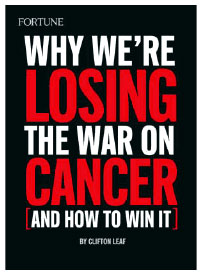
Scientific Problem Cancer is a group of over 100 diseases and unlike normal cells, the cells in cancers change the three-billion-letter DNA code when they replicate. This is a major obstacle.
Download a copy of
Why we’re Losing The War On Cancer and How to Win It! PDF

We are not winning the war on cancer

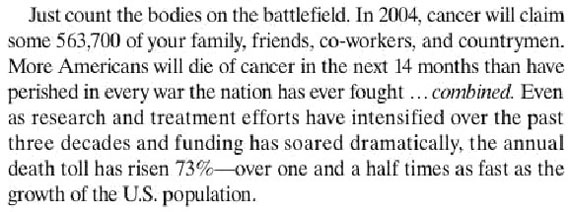
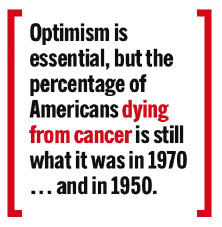
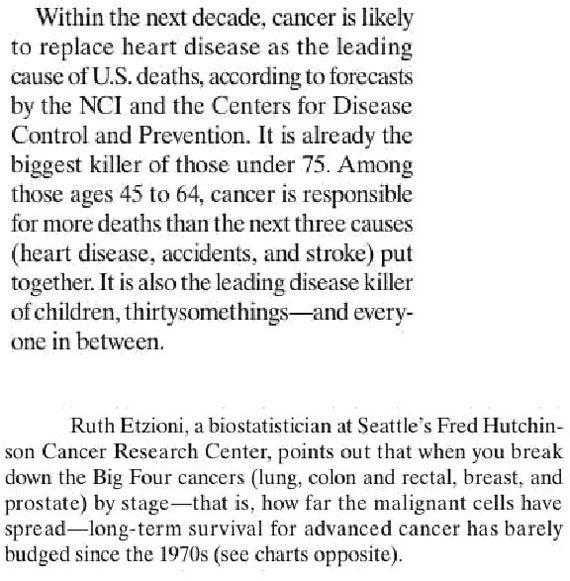

War on Cancer
In 1971 Nixon initiated a major war on cancer. The industry feuded over how centralized of a role the government should have and how the money should be spent.
Sidney Farber, the Boston physician known as the godfather of cancer research did not want to wait for the industry to academically understand the complicated workings of cancer, rather he wanted to get busy treating people even if the methods used would not be fully understood.
Dr. Farber who wanted a government controlled unified assault on cancer, testified in 1971 congressional hearings that…

Farber lost.
Since 1971 we have wasted billions on trying to understand the diseases and getting useless cancer drugs approved before they can be used, loosing over 1500 people per day!
This has been a highly profitable business for both researchers and the patent-drug
corporations. However this has not created any benefits for the sick because this kind of a
for profit system will only reward those taking minimum risk; finding tiny improvements in
a far distant corner of the cancer world. When scientists are asked what they think of this
system they talk of “dysfunctional cancer culture”

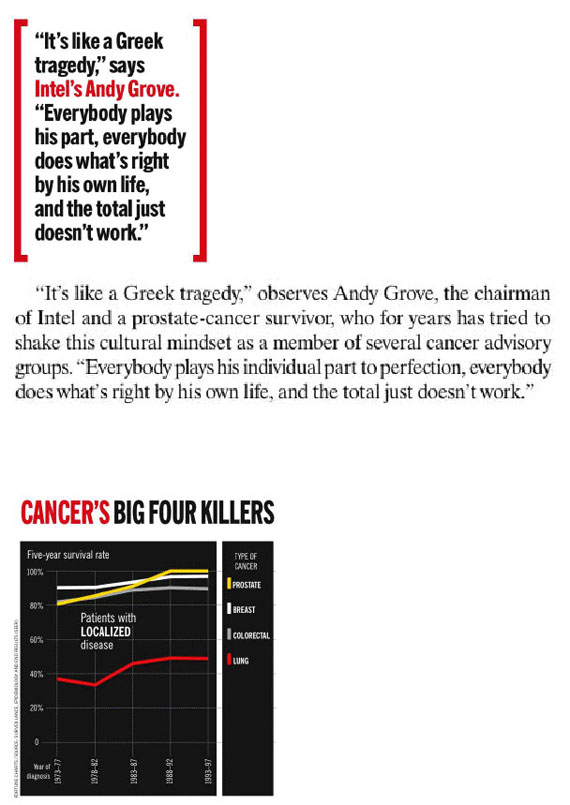
The Money
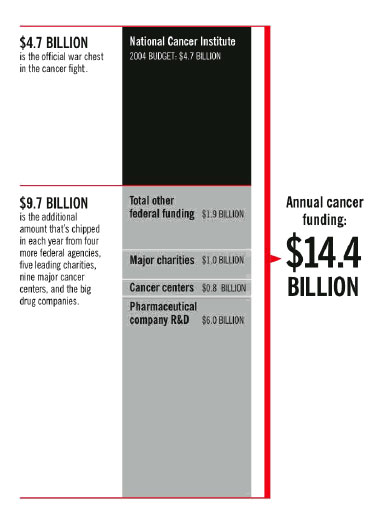
The Mouse
It has been known for one or two decades that preclinical human cancer models have very
little predictive power in terms of how actual human tumors, inside patents, will respond.
So the tumors that arise in each, with the same flip of a genetic switch, are vastly different.
Says Weinberg: “ A fundamental problem with remains to be solved in the whole cancer
research effort, in terms of therapies, is that the preclinical models of human cancer, in large
part, stink”
As explained by Bruce Chabner, professor of medicine at Harvard and clinical director at the
Massachusetts General Hospital Cancer Center: the “instant tumors” that researchers cause
in miche simply can’t mimic human cancer’s most critical and maddening trait, its quick
changing DNA.
Homer Pearce, former cancer research and clinical investigator at Eli Lilly and is now
research fellow at the drug company agrees that mouse models are “woefully inadequate”
for determining whether a drug will work in humans: If you look at the millions and
millions and millions of mice that have been cured, and you compare that to the relative
success, or lack thereof, that we’ve achieved in the treatment of metastatic disease
clinically” he says, “you realize that there just has to be something wrong with those models.
Vishva Dixit, a VP for research in molecular oncology at Genentech in South San Francisco,
is even more horrified that “99% of investigators in industry and in academia use
xenografts.” Why is the mouse model so heavily used? Simple. “it is very convenient, easily
manipulated, “Dixit explains. “You can assess tumor size just by looking at it.”
If everyone understands the problem, why isn’t anything being done?
Two reasons, says Weinberg. First, there’s no other model with which to replace the
poor mouse. Second, he says, “is that the FDA has created inertia because it continues to
recognize these [models] as the gold standard for predicting the utility of drugs.”
====.
METASTASIZING CELLS
It is not localized tumors that kill people with cancer; it is the process of metastasis – and
incredible 90% of the time. Aggressive cells spread to the bones, liver, lungs, brain, or other
vital areas, wreaking havoc.
NCI grants going back to 1972 show that less than 0.5% of study proposals focused
primarily on metastasis. Of the tens of thousands of grant proposals awarded, over 90%
even don’t mention the word metastasis.
M.D. Anderson’s Josh Fidler suggests that metastasis is getting short shrift simply
because “it’s tough. Okay? And individual are not rewarded for doing tough things.” He
claims grant reviewers are more comfortable with the studies that use antibody on a
specific cancer.
FDA mandate is to make sure that a drug is safe and that it works before allowing its sale
to the public. Thus, the regulators need to see hard data showing that a drug has had some
effect in testing.
However, it’s hard to see “activity” in preventing something from happening in the first
place. There have been little funding in the area so the biomarkers have not been found.
[check Ralph Moss]
Drug companies don’t focus on metastasis (the thing that kills 90% of cancer patients)
instead they focus on shrinking tumors (the thing that kills 10% of cancer pateints).
Those ineffective drugs keep getting approved with FDA. However here as in other cases in
the patent-drug industry, the new drugs are not any better than the new ones – just more
expensive.
FDA REWARDS INCREMENTAL IMPROVEMENTS
The flawed models for cancer drug development:
Obsession with tumor shrinkage. Focus on cell functions to the near exclusion of what’s
happening in the organisms as a whole.
Clinical trials are so arduous and expensive that it takes 12 to 14 years to develop and over
$800 million.
This rewards companies that spend huge time and vast money on proving that their drugs
work – even if the drug only works a little better than the last one. For example shrinks
tumors 10% better than previous drugs.
No one wants to risk spending over $800 million on a drug that deals with the problem of
metastasis when the rules to get it approved focus more on the science than the cure.
WHAT NEEDS TO HAPPEN
Doctors need the freedom to administer drugs in combination because tumors recruit blood
vessels through several signaling mechanisms, researchers believe, so the best approach is
to apply several drugs, cutting off all routes.
He concludes that we need to move away from “the rules governing drug approval to tort
law and intellectual property rights” and that: “Science now has the knowledge and the
tools; we need to act.”
I agree that we need to move away from FDA rules governing drug approval, but I disagree
that we need to replace those with tort law and intellectual property rights.
Profiteering on cancer, through intellectual property rights, is one of the main hindering
factors to finding the true cure for cancer.
In fact like with many other industries, the solution is already available but suppressed.
The cure for cancer has been made available by a number of immune supporting therapies
for decades. Those methods have been vilified, ridiculed and suppressed by the scientific
community.
If we were in a court of law, arguing a murder case, the evidence would suffice to persuade a
jury.
When it comes to curing cancer using lifestyle, food and supplements the burden of proof
becomes overwhelming.
Let me mention an example. Dr. Hulda Clark presented meticulous case histories of over
50 people that she treated for cancer in her book “The Cure for All Advanced Cancers”. The
success rate for advanced cancer is about 95%
Those case histories were supported with before and after x-rays and other medical
information. So you can count on this method, not merely hope it will work for you. It is
a total approach that not only shrinks tumors, but also normalizes your blood chemistry,
lowers your cancer markers, and returns your health. The small failure rate (5%) is due to
clinical emergencies that beset the advanced cancer sufferer. However, if you combine the
advice in this book with access to hospital care, even “hopeless” patients can gain the time
necessary to become well again.
If a jury would be asked to deliberate and decide if cancer can be cured using her methods
and they were given the evidence in the book, I am confident they would rule that Dr. Hulda
Clark did actually cure those people.
However this is not the experience Dr. Clark had when asking an oncologist to testify if the
x-rays and medical information presented indicated a cure of cancer. The doctor simply
asked for a biopsy. He told Dr. Clark that he could not testify that the original series of x-
rays he had in his hands, that clearly indicated a shrinking tumor, indicated that it was in
fact tumor. He needed a biopsy to be conclusive.
The laws governing medical treatment need to be changed to primarily support natural
therapies, that incorporate lifestyle, food and supplements.
LIST OF DRUGS
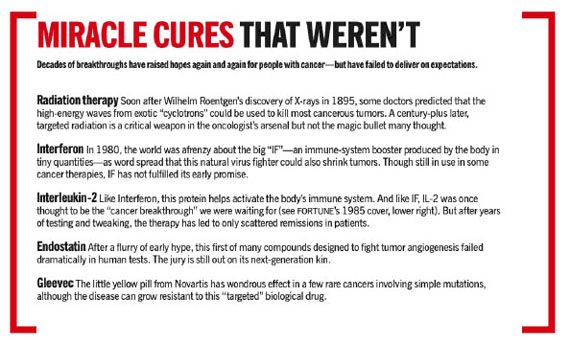
Alien Control – Discover Magazine
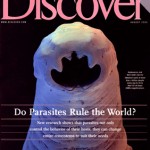
“Every living thing has at least one parasite that lives inside or on it, an many, including humans, have far more.”
“…parasites have largely been neglected.”
This article agrees with Dr. Hulda Clark’s view that scientists have overlooked the role of parasites in humans.
Download a copy of Parasites Rule The World? PDF
Parasites in Women and Men (funny)
By Jane Bunce
A COMMON parasite can increase a women’s attractiveness to the opposite sex but also make men more stupid, an Australian researcher says.
About 40 percent of the world’s population is infected with Toxoplasma gondii, including about eight million Australians.
Human infection generally occurs when people eat raw or undercooked meat that has cysts containing the parasite, or accidentally ingest some of the parasite’s eggs excreted by an infected cat.
The parasite is known to be dangerous to pregnant women as it can cause disability or abortion of the unborn child, and can also kill people whose immune systems are weakened.
Until recently it was thought to be an insignificant disease in healthy people, Sydney University of Technology infectious disease researcher Nicky Boulter said, but new research has revealed its mind-altering properties.
“Interestingly, the effect of infection is different between men and women,” Dr. Boulter writes in the latest issue of Australasian Science magazine.
“Infected men have lower IQs, achieve a lower level of education and have shorter attention spans. They are also more likely to break rules and take risks, be more independent, more anti-social, suspicious, jealous and morose, and are deemed less attractive to women.
“On the other hand, infected women tend to be more outgoing, friendly, more promiscuous, and are considered more attractive to men compared with non-infected controls.
“In short, it can make men behave like alley cats and women behave like sex kittens”.
Dr. Boulter said the recent Czech Republic research was not conclusive, but was backed up by animal studies that found infection also changes the behavior of mice.
The mice were more likely to take risks that increased their chance of being eaten by cats, which would allow the parasite to continue its life cycle.
Rodents treated with drugs that killed the parasites reversed their behavior, Dr. Boulter said.
Another study showed people who were infected but not showing symptoms were 2.7 times more likely than uninfected people to be involved in a car accident as a driver or pedestrian, while other research has linked the parasite to higher incidences of schizophrenia.
Toxoplasma Infection Increases Risk Of Schizophrenia, Study Suggests
ScienceDaily (Jan. 16, 2008) — Findings from what is believed to be the largest comparison of blood samples collected from healthy individuals and people with schizophrenia suggest that infection with the common Toxoplasmagondii parasite, carried by cats and farm animals, may increase the risk of schizophrenia.
History
The protozoan was first discovered by Nicolle &Manceaux, who in 1908 isolated it from the African rodent Ctenodactylusgundi, then in 1909 differentiated the disease from Leishmania and named it Toxoplasmagondii.[20] The first recorded congenital case was not until 1923, and the first adult case not until 1940.[20]In 1948, a serological dye test was created by Sabin & Feldman, which is now the standard basis for diagnostic tests.[37]
Notable people
Arthur Ashe (tennis player) developed neurological problems from toxoplasmosis (and was later found to be HIV-positive).[38]
Merritt Butrick (actor) was H.I.V positive. Died from toxoplasmosis as a result of his already weakened immune system.[39]
Prince François, Count of Clermont (pretender to the Throne of France); his disability has caused him to be overlooked in the line of succession.
Leslie Ash (actress) contracted toxoplasmosis in the second month of pregnancy.[40]
Sebastian Coe (British middle distance runner)[41]
Martina Navrátilová (tennis player) retired from a competition in 1982 with symptoms of a mystery ‘virus’ that were later found to be due to toxoplasmosis.[42]
Louis Wain (artist) was famous for painting cats; he later developed schizophrenia, which some believe was due to toxoplasmosis resulting from his prolonged exposure to cats.[43]
Dr. Clark’s Parasite Pictures
These are actual pictures – Not microscope images.
Images of parasites from recent American patients of Hulda Clark, Ph.D.
Dr. Clark has found the Liver Cleanse is the best way to get the parasites out undamaged enough so they can be identified.

Disintegrated tapeworm looks like a pile of porridge, grey or beige, slightly rubbery. Dark spots are debris.
Micro current history
Microcurrent has been used for thousands of years. Ancient Egyptians used catfish. In 46 A.D. Dr. Largus used the black torpedo fish to treat gout. In 1745 the Leyden Jar was developed as a capacitor and in 1919 the Electreat was used similarly to a TENS unit. A recent pioneer in the field was Dr. Thomas Wing. He developed the Acu-O-Matic device in 1970. Things have continued to develop since that time to the current devices that are available.
In 1982-1983 Kaada did studies that showed TENS devices were successful in pain relief for neuropathy, raynoids and chronic leg ulcers. He continued his studies on leprous ulcers, vasodilation, fibromyalgia, mild to moderate hypertension and tinnitus, all with positive results. Studies have shown burns heal faster with the application of microcurrent and silver nylon fabric.
Another important study was done by Grace Halloran, Ph.D., in 1983-85. She studied the effects of microcurrent in the treatment of macular degeneration. The results of her study were published in the Townsend Newsletter in October, 2002. Eighteen patients had macular degeneration and 16 improved. Seventy eight had retinitis pigmentosa and 62 showed improvement. Eighteen patients had other various retinopathies and 16 improved. In the study only 2 patients out of the 114 continued to lose vision and in these cases the loss was slow.
Microcurrent
Microcurrent operates on the premise that less is better. The smaller the amperage the more effective the treatment. Higher currents block pain and lower currents stimulate healing. In general these devices are believed to improve circulation, reduce scar tissue and stimulate cellular activity. TENS devices operate at a higher amperage (1-5 milliamps) and will block pain. Microcurrent devices are at a lower amperage (20-400 micro amps) and stimulate cellular activity. Theoretically, on a cellular level, microcurrent increases adenosentriphosphate (ATP) production in the mitochondria which has a cascade effect on the neuro-endocrine system, organ systems and chemical systems.
Case studies were reviewed including prostate, macular degeneration, clinical applications of micro-light, emotional therapy, microcurrent regeneration of an industrial crush hand injury, chronic back pain, trauma and facial rejuvenation. There are cases where microcurrent is not recommended. These include, but are not limited to patients with pacemakers, seizure disorders and current or recent cancer.
http://www.faim.org/energymedicinedevices/microcurrentcaseconf08.html

